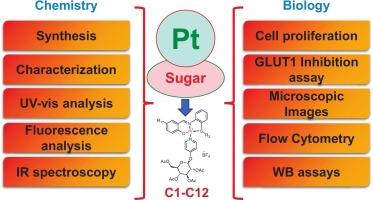基于乙酰化单糖功能化共配体的强抗癌Pt(II)配合物:合成、表征和生物学分析
IF 3.2
2区 化学
Q2 BIOCHEMISTRY & MOLECULAR BIOLOGY
引用次数: 0
摘要
在这项研究中,我们用单糖功能化吡啶共配体修饰了基于ons供体的三齿水杨醛二胺为主配体的Pt(II)配合物。首先用AgBF4萃取起始配合物的辅助性氯离子,然后加入乙酰化的β-d-葡萄糖共轭吡啶,通过两步连续反应制得C1-C12配合物。分析了这些复合物对人胃癌mkn45、结肠癌RPMI 4788和非小细胞肺癌A549细胞的体外抑癌作用。C9和C12是最有效的复合物,这些复合物在顺铂耐药人非小细胞肺癌A549/DDP细胞和人正常细胞胃上皮GES和结肠上皮NCM 460细胞中进一步研究。抗肿瘤作用在顺铂耐药细胞中较好,在人正常细胞中较低。为了显示糖对选定复合物(C9和C12)和对照(奥沙利铂)生理行为的影响,在癌细胞中进行了GLUT1抑制剂(槲皮素)依赖的实验,发现在C9和C12存在的情况下添加GLUT1抑制剂后,癌细胞死亡率降低,表明这些复合物具有GLUT1依赖的抗癌活性,而GLUT1抑制剂的存在不影响作为对照的奥沙利铂的细胞毒性。通过明光场图像、hoechst 33342染色和流式细胞术分析进一步证实了这些复合物的强凋亡作用。Western blot分析揭示了这些复合物诱导PARP、caspase 3和BCL-2的机制,从而导致癌细胞死亡。本文章由计算机程序翻译,如有差异,请以英文原文为准。

Acetylated monosaccharide functionalized co-ligand based strong anticancer Pt(II) complexes: Synthesis characterization and biological analyses
In this study, we modified ONS-donor tridentate salicylaldimine main ligand-based Pt(II) complexes with monosaccharide functionalized pyridine co-ligand. All these complexes (C1-C12) were prepared in two steps continuous reaction by firstly, abstracting the ancillary chloride of the starting complexes with AgBF4 and secondly, adding the acetylated β-d-glucose conjugated pyridine. All these complexes were analyzed for their in vitro anticancer potency in human's gastric cancer MKN 45, colon cancer RPMI 4788 and non-small cell lung cancer A549 cells. C9 and C12 were the most potent complexes, these complexes were further studied in cisplatin-resistant human non-small cell lung cancer A549/DDP cells and human normal cells gastric epithelial GES and colonic epithelial NCM 460 cells. The anticancer effects were superior in cisplatin-resistant cells and lower in human normal cells. To show the effect of sugar on the physiological behavior of selected complexes (C9 and C12) and control (oxaliplatin), GLUT1 inhibitor (quercetin)-dependent experiments were performed in cancer cells that revealed lower cancer cells death after GLUT1 inhibitor was added in the presence of C9 and C12, indicated that these complexes exhibited GLUT1-dependent anticancer activity while the presence of GLUT1 inhibitor did not affect the cytotoxicity of oxaliplatin used as a control. Cell morphological study using bright field images or hoechst 33342 staining and flow cytometry analyses were conducted to further confirm the strong apoptotic effect of these complexes. Western blot analyses were performed that revealed mechanistically these complexes induced PARP, caspase 3 and BCL-2 and thereby caused cancer cell death.
求助全文
通过发布文献求助,成功后即可免费获取论文全文。
去求助
来源期刊

Journal of Inorganic Biochemistry
生物-生化与分子生物学
CiteScore
7.00
自引率
10.30%
发文量
336
审稿时长
41 days
期刊介绍:
The Journal of Inorganic Biochemistry is an established international forum for research in all aspects of Biological Inorganic Chemistry. Original papers of a high scientific level are published in the form of Articles (full length papers), Short Communications, Focused Reviews and Bioinorganic Methods. Topics include: the chemistry, structure and function of metalloenzymes; the interaction of inorganic ions and molecules with proteins and nucleic acids; the synthesis and properties of coordination complexes of biological interest including both structural and functional model systems; the function of metal- containing systems in the regulation of gene expression; the role of metals in medicine; the application of spectroscopic methods to determine the structure of metallobiomolecules; the preparation and characterization of metal-based biomaterials; and related systems. The emphasis of the Journal is on the structure and mechanism of action of metallobiomolecules.
 求助内容:
求助内容: 应助结果提醒方式:
应助结果提醒方式:


